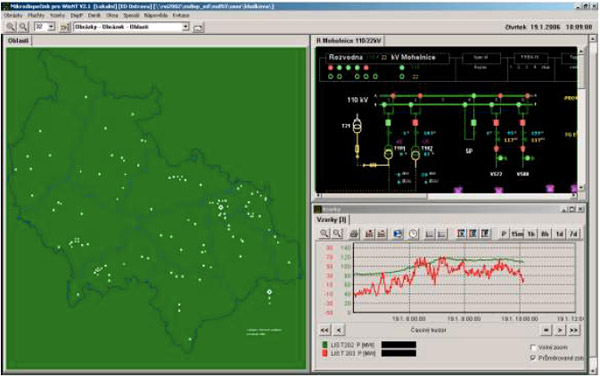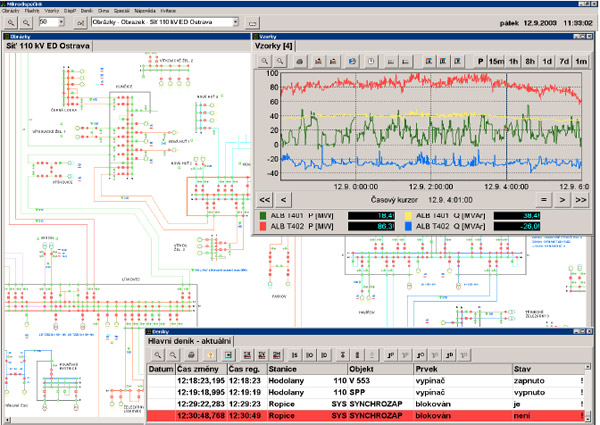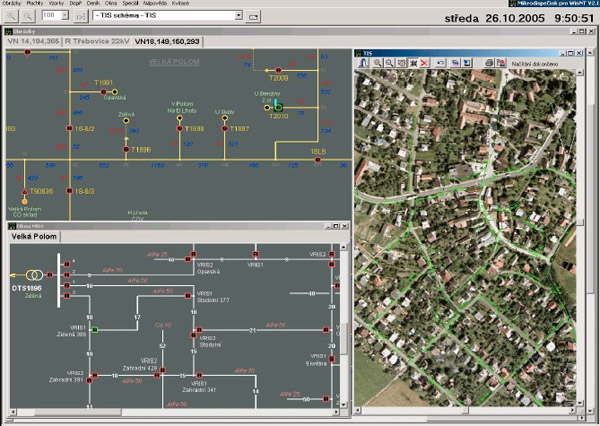SCADA Microdispatch
PRODUCTS AND SOLUTIONS FOR MONITORING AND CONTROL IN THE ENERGETICS

SCADA Microdispatch
Microdispatch is a specialized SCADA system for the monitoring, control and evaluation of processes in real time which is particularly recommended for the control of electrical networks with high, medium and low voltage, for applications in power stations and in control centers. The system enables the safe and effective control of technology from the control center, integrates control systems in power stations and networks into one unit, and provides actual images of the controlled technology, historical data and eventually the predicted data. It creates a support for the preparation, operative control and the consequent evaluation of the operatinal processes.
System description
Microdispatch can be operated on servers and client stations with OS MS Windows, for data storage there can be used a cluster solutions working with other operating systems (Unix, Linux). Standard HW and SW is used, no special HW and SW is required. The creation and maintenance of SW SCADA Microdispatch is usually implemented in the Borland Delphi development environment. The Microdispatch control system is designed with maximum modularity and an open character. The basic interface for data access is at the level of DLL, COM/DCOM, UDP/IP and TCP/IP.
The configuration of the real control system is created by writing the data into configuration tables and drawing diagrams in the graphic editor. Important attributes of the system are reliability, easy applicability, preparation for connection with systems from other suppliers, effective maintenance and focus on the user. The system is designed on a modular principle, is sufficiently adaptable, expandable and enables problem-free interconnection with further systems. It ensures maximum accessibility of data from the individual integrated monitoring and control systems.
The control systems for power stations and control center are integrated into LAN and WAN SCADA. The system in the control center is designed in a standard manner with certain HW redundancy. This redundancy ensures, in the case of a breakdown of one or more elements, the access of functions and data and the minimal or no restriction for users. Remote service and user access is possible in the system, including access through the Intranet (Internet). The system enables the backup, including control from another workplace or from another locality. It enables the operative change of the scope of the area controlled from each workplace. The uniform central model of the whole controlled electricity network is important for ensuring the effective and safe system administration, individual data and outputs for users. In one control system, there is an actual telemetric, eventually manually inserted image of all controlled networks of high, medium and low voltage. Maximum access to data from individual integrated control systems is ensured. In the case of non-accessibility of the master system, usually in the control center, the work is done by local data copy. In this time, the restriction is only in the fact that in subordinated systems it is not possible to create and edit shared data; the telemetric data remains actual.
During the resolution of the communication with other systems, standard input/output communication interfaces are used. Microdispatch can also run as a mediator between various mutually incompatible systems that cannot be directly connected. It can also be operated as a data concentrator and as a simple or network communication server. Various types of communications are used, point to point and point to multipoint, including communication through GSM CSD and GPRS (according to available mobile network generation in the stated region). Microdispatch has the implemented support of communication TG 800 Master and Slave (point to point, transit, line emulation), IEC 870-5-x, MDXL including network version, MCS, CVM Modbus, DMS, DO100, SAIA S-Bus and others, with the RTU Communicator there is available also protocol IEC 61850. Great attention is focused on data security, particularly during the control when the blocking conditions can be also evaluated. In the case of a request for the connection of Microdispatch to another system, some of the currently directly supported serial communications, including network, COM/DCOM interfaces can be used, eventually a further type of interface or communication can be included into the system.
From the user’s point of view, the following brief list of functions can be given
- Images – iagrams of electric stations and networks with the actual statuses and values of measurement, with the option to place marks and comments, with control, with possible change of the scale of display and switching into further diagrams.
- Diary – protocol with changes and alarm messages with wide options of the filtration for the displaying, confirmation of changes, insertion of comments, consequent processing of archived data.
- DispP – the module automatically evaluates the actual and planned values of loading supports trade dispatching control in real time.
- Sheets – actual and archive summaries of measurements of hourly sections, maximal, minimal and mean values of loading, including archiving and possible consequent off-line processing.
- Samples – module for sampling and archiving of all changes of measurement values, with on-line and off-line processing of the values in graphs.
- Change calculations – this function enables to perform effective, fast and secure generation and maintenance of the control system and automatic outputs for displaying, supports the transparency of the system from the viewpoint of the user during the accumulation of changes.
- Simulation of connection – the user can set the required configuration (model) of the network with the consequent automatic recalculation of the topology and evaluation (colouring) of the network parts and consumers without voltage (for ex. during a downtime).
- Colouring of diagrams – according to various criteria it is possible to colour the diagrams of the electric stations and networks, e.g. according to sources, i.e. with the indication of the connection to the defined supply node, etc.
- Sending SMS and e-mails – information about changes to specified signals or user-entered text messages can be sent automatically via GSM and intranet.
- WEB access – the pages use the advantages of web technologies. Necessary components are downloaded automatically to the user´s PC. The access to SCADA data is possible through the intranet (Internet), including the option of mobile access through GSM.
- Display of information from TIS/GIS/CIS (orthophotomap, customers, …) to the selected object in the control system (to secondary subsattion, line section, …).
REFERENCES
- CEZ Bulgaria
- CEZ ROMANIA
- ENERGO-PRO Georgia
- Energetika Třinec, a. s.
- Veolia Energie ČR, a. s.
- DEZA a.s.
- Energetika Vítkovice
- E.ON ČR a.s. – HMI in primary substation
- ČEZ distribuce a.s. – HMI in primary substations

